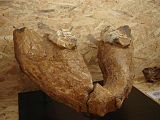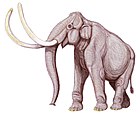互棱齒象屬化石时期:晚
中新世 -早
更新世 Late Miocene至Early Pleistocene
互棱齒象(A. arvernensis )骨架化石
科学分类
界:
动物界 Animalia
门:
脊索动物门 Chordata
纲:
哺乳纲 Mammalia
目:
长鼻目 Proboscidea
科:
† 互棱齒象科
属:
† 互棱齒象屬 Anancus Aymard , 1855
種
A. alexeevae Baigusheva, 1971A. arvernensis (Croizet and Jobert, 1828) (模式種 )A. capensis Sanders, 2007A. cuneatus Teilhard de Chardin and Trassaert, 1937A. kazachstanensis Aubekerova, 1974A. kenyensis MacInnes, 1942A. lehmanni (Gaziry, 1997)A. osiris Arambourg, 1945A. perimensis (Falconer and Cautley, 1847)A. petrocchii Coppens, 1965A. sinensis Hopwood, 1935A. sivalensis (Cautley, 1836)A. ultimus Sanders, 2011
互棱齒象屬 (學名 :Anancus 長鼻目 互棱齒象科 下已滅絕 的一屬,生存於中新世 晚期至更新世 早期(約700-150萬年前)的非洲 、歐洲 與亞洲 。
互棱齒象復原圖 互棱齒象(A. arvernensis) 互棱齒象屬為互棱齒象科的模式屬,最早由奧古斯特·艾馬德 嵌齒象科 下,但在之後由McKenna & Bell (1997)、Kalb & Froelich (1995)、Shoshani & Tassy (2005)改分類至象科 。之後Hautier et al. (2009)將互棱齒象屬分類於嵌齒象科的互棱齒象亞科下[ 1] [ 2] [ 3] [ 4]
互棱齒象屬肩高可達3米(9.8英尺),體重可達55公噸(4.9長噸;5.5短噸),外型與現存大象 近似[ 5] 象牙 ,最長可達4米(13英尺)[ 6] [ 7] [ 8] 臼齒 和現今的大象不同,不具有皺褶,而是具有牙尖,類似於貘 或豬 的臼齒。互棱齒象棲息於森林 ,推測牠們是以樹 和灌木 還有挖掘地下的塊莖與塊根 為食,當森林逐漸被草原取代時,互棱齒象也走向滅絕[ 6] 衣索比亞 互棱齒象牙齒化石琺瑯質 中的碳同位素 分析卻顯示,牠們主要是以C4類植物 為食[ 9]
^ Hautier, Lionel; Mackaye, Hassane Taisso; Lihoreau, Fabrice; Tassy, Pascal; Vignaud, Patrick; Brunet, Michel. New material of Anancus kenyensis (proboscidea, mammalia) from Toros-Menalla (Late Miocene, Chad): Contribution to the systematics of African anancines. Journal of African Earth Sciences. March 2009, 53 (4–5): 171–176. Bibcode:2009JAfES..53..171H doi:10.1016/j.jafrearsci.2009.01.003 ^ Shoshani, Jeheskel; Tassy, Pascal. Advances in proboscidean taxonomy & classification, anatomy & physiology, and ecology & behavior. Quaternary International. January 2005,. 126-128: 5–20. Bibcode:2005QuInt.126....5S doi:10.1016/j.quaint.2004.04.011 ^ Shoshani, J. ; Tassy, P. Summary, conclusions, and a glimpse into the future. Shoshani, Jeheskel; Tassy, Pascal (编). The Proboscidea: Evolution and Palaeoecology of Elephants and Their Relatives . Oxford University Press. 1996: 335 –348. ISBN 978-0-19-854652-8 ^ Mothé, Dimila; Ferretti, Marco P.; Avilla, Leonardo S. The Dance of Tusks: Rediscovery of Lower Incisors in the Pan-American Proboscidean Cuvieronius hyodon Revises Incisor Evolution in Elephantimorpha . PLOS ONE. 12 January 2016, 11 (1): e0147009. Bibcode:2016PLoSO..1147009M PMC 4710528 PMID 26756209 doi:10.1371/journal.pone.0147009 ^ http://donsmaps.com/mastodon.html (页面存档备份 ,存于互联网档案馆 ) Mastodons and related early elephants^ 6.0 6.1 Palmer, D. (编). The Marshall Illustrated Encyclopedia of Dinosaurs and Prehistoric Animals . London: Marshall Editions. 1999: 241 . ISBN 1-84028-152-9 ^ The Free Dictionary: Tusks . [2021-08-07 ] . (原始内容 存档于2022-01-31). ^ Upali.ch Elephants in Zoo and Circus (页面存档备份 ,存于互联网档案馆 ), Teeth, second dentition, tusks.^ Levin, Naomi E.; Haile-Selassie, Yohannes; Frost, Stephen R.; Saylor, Beverly Z. Dietary change among hominins and cercopithecids in Ethiopia during the early Pliocene . Proceedings of the National Academy of Sciences. 6 October 2015, 112 (40): 12304–12309. Bibcode:2015PNAS..11212304L PMC 4603467 PMID 26371308 S2CID 205272461 doi:10.1073/pnas.1424982112
Benes, Josef. Prehistoric Animals and Plants. Prague: Artua. 1979: 263.









